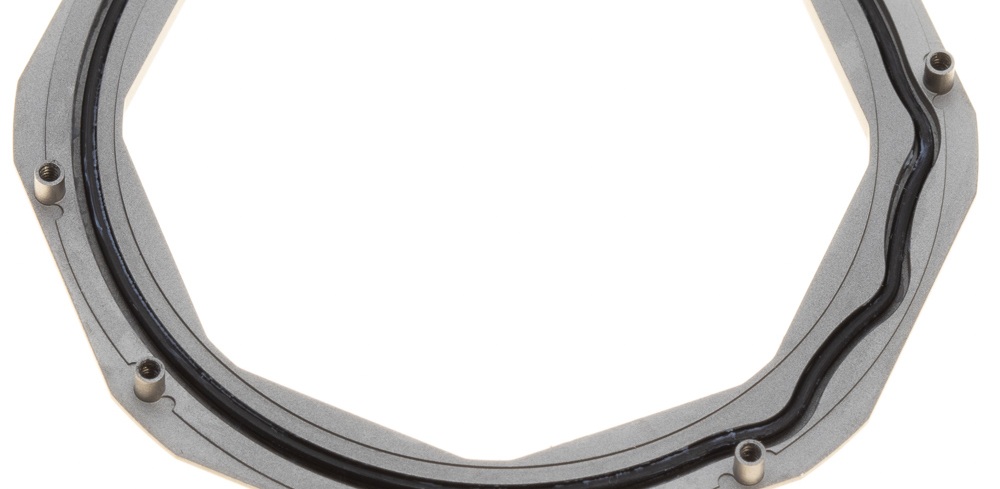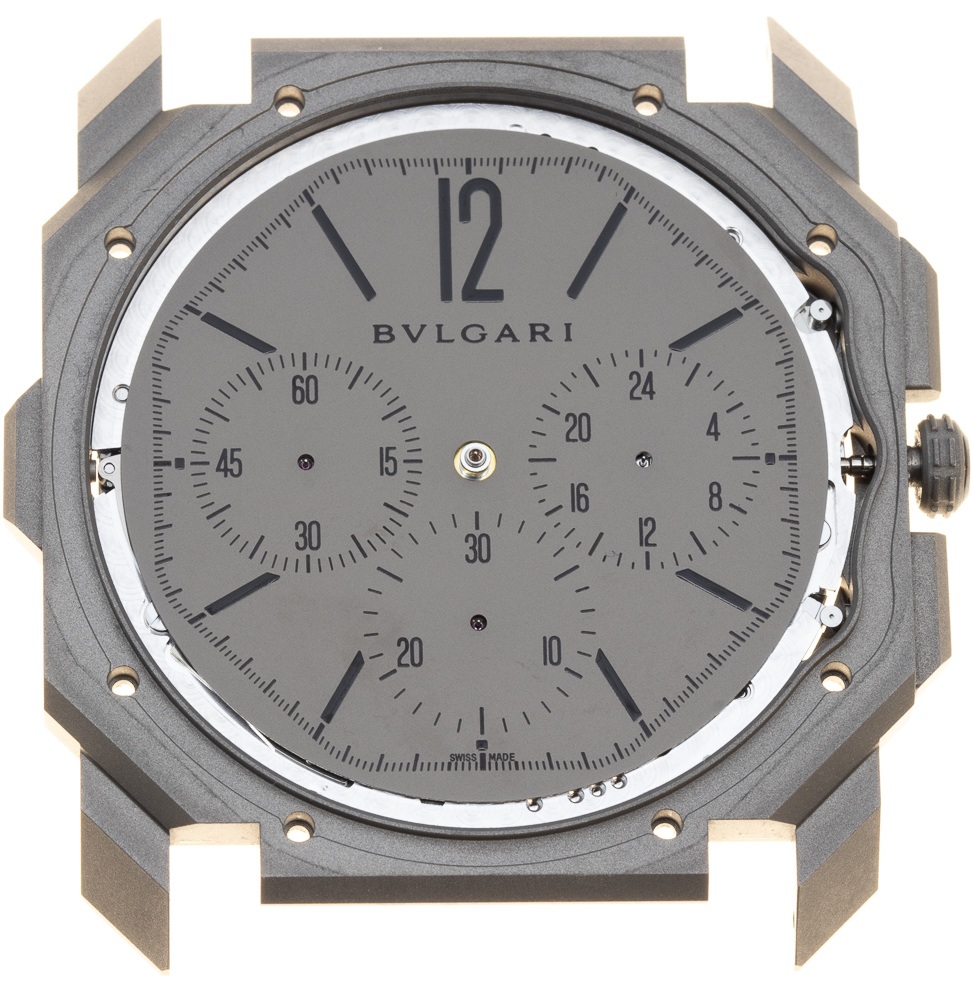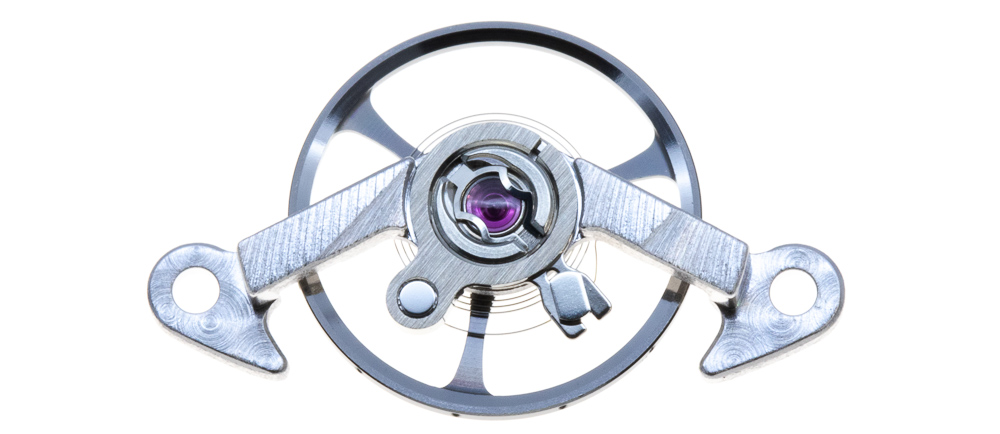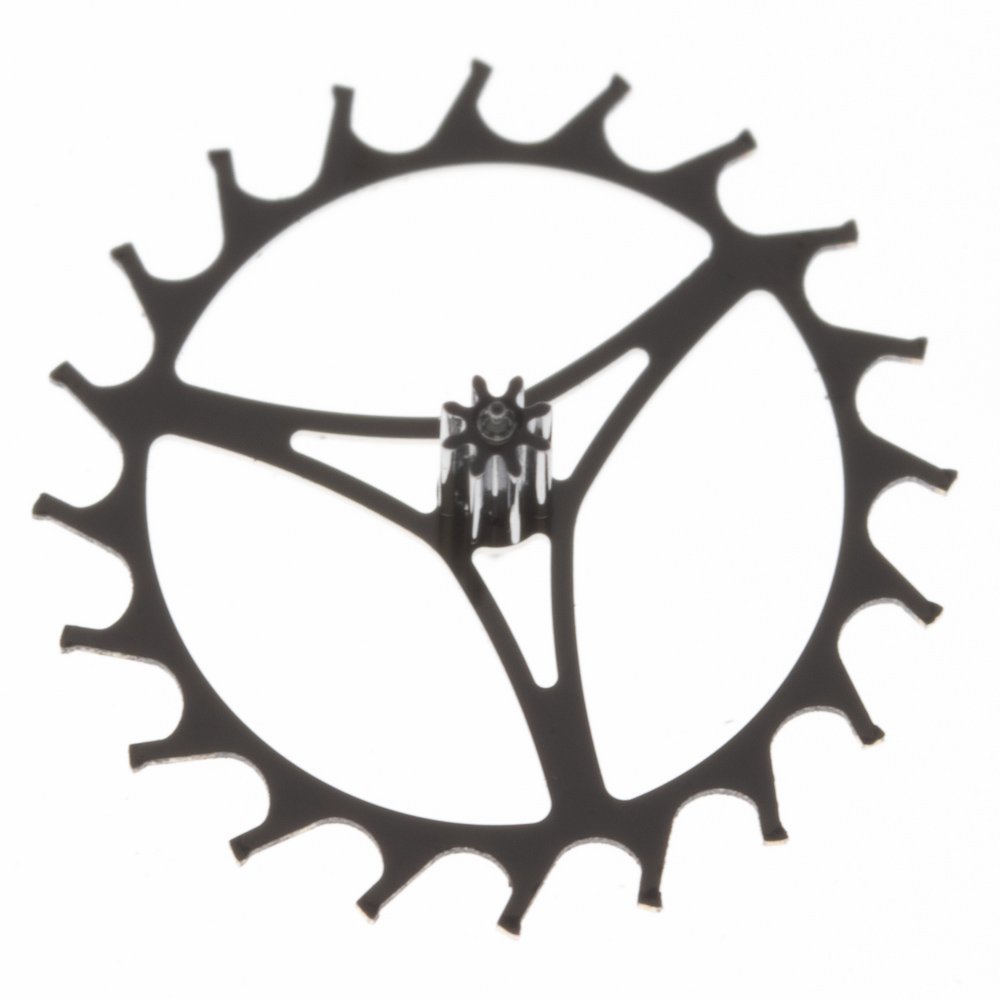The Reason
Bulgari's fifth world record time piece, Octo Finissimo Chronograph GMT, the slimmest timepiece of its kind to be produced to date (2019).
The constant small seconds hand is set at 9 o'clock, the minute recorder measuring upto 30 minutes at 6 o'clock, with a central chronograph seconds hand. The 24 hour hand set at 3 o'clock is intended for home time. The pusher set into the left hand side of the case corrects independently the main central hour hand to adjust for local time/second time zone.
The total thickness of case 6.9mm, diameter 42mm. Made from sandblasted titanium. Dial colour sandblasted titanium. Water resistant to 30 meters. Bracelet sandblasted titanium with folding clasp. Calibre BVL 318 Thickness: 3.3mm and diameter 37.2mm. Power Reserve 55 hours. Automatic winding with a peripheral platinum rotor. There are 37 jewels set into the calibre.
Please move the cursor across the image below, (or by finger on a smart phone), to rotate the watch.
Profile image showing the integration of the chronograph pushers and the ceramic set winding crown into the case.
The case back is held in place by 4 pentagonal screws and is set with a large diameter sapphire crystal allowing the majority of the rotor to be viewed.
The movement comprises of 433 components
The three pushers for the chronograph and for adjusting second time zone function.
Chronograph pushers
Second time zone corrector pusher
Recto-verso of the watch-head with the bracelet removed. The bracelet is held between the shoulders by a long spring loaded pin bar. The bracelet is placed into position and removed only from the back of the watch.
Case back removed.
The decoration on the bridges are Geneva stripes
The bezel is removed by unscrewing the 8 stainless steel screws which are hidden under the case back.
The underside of the bezel is milled to allow the rubber ‘O’ joint to follow an irregular path form, around the section where the pushers are screwed into the inner case.
Bezel and case back removed.
The hands are removed from the dial with wide headed (spatula-like), sharp hand removing levers.
The dial removed showing the corrector mechanism for adjusting the second time zone.
The dial is a friction fit onto the movement, held in place by 2 dial feet. The minute and hour hands are faceted to catch the light and always assure clear visibility of the time.
The movement removed from the case.
The pushers for the GMT and chronograph are screwed in place from the inside of the case and have rubber seals set inside the pusher tubes.
To remove the movement from the case the stem is removed first, then re-assembled afterwards.
Bridge side of movement
Dial side of movement
To facilitate the assembly and disassembly of the watch, the stem is made in two pieces and clips together. The same system was used in the 1970’s with sports watches which prevented conventional access to the stem for it to be removed.
The second time zone corrector mechanism.
The balance bridge is milled low around its screw sections to allow the rotor wheel teeth to pass above the bridge.
The large steel wheel in the centre is the ratchet wheel which when wound, winds the mainspring. The wheel to its left is the last wheel in the automatic winding train. The wheels to the right are for manual winding.
Recto-verso of the peripheral rotor weight. Designed to avoid adding layers on the calibre and increasing its thickness. Whilst the outer section with platinum mass connected to the large steel wheel is free to rotate on ceramic balls, the central section is secured to the movement.
Three screws hold the rotor in place sandwiching the central steel ring between two rubber shock absorbers. The lower in chimney form, the higher a conventional ring form. The screws tighten to the central metal pipe but the rubber shock protectors allow for a small movement in case of impact or any variations in the concentricity of the large steel ring.
The inner teeth of the peripheral rotor weight mesh on the first wheel in the automatic gear train, that can be seen at 9 o’clock on the image below protruding out from under the decorated bridge.
The balance assembly including bridge.
The balance wheel oscillates at a frequency of 4 hertz, (28,800 vibrations/hour).
The view of movement with the balance removed.
The Swiss lever bridge.
The escape wheel and Swiss lever.
The escapement removed.
The upper fourth wheel which drives the chronograph train, removed from extended pivot of the lower fourth wheel.
The bridge removed which holds in place the majority of the chronograph wheels.
The pillar or column-wheel is the brain of the chronograph, indexed by the pusher at 2 o'clock on the case to activate and deactivate the chronograph mechanism. It will also block the return to zero pusher if the chronograph is still running.
The chronograph system is conventional in conception but has been rethought to reduce the overall thickness of the movement. Still remaining classically strong in its overall construction. There are no elements which have been compromised in their function and strength due to the thickness of the calibre.
A selection of the chronograph components.
The largest lever in the chronograph construction is the coupling clutch which meshes with the upper third wheel and drives the chronograph.
The hammer piece which returns to zero the chronograph wheels.
The automatic train is held primarily in place by a single bridge which allows 6 wheel to pivot. The system is far more complex than conventional automatics as a result of the constraints in thickness, combined with the need for a highly efficient automatic winding mechanism. There are multiple ceramic ball races as well as the use of copper beryllium wheels (which are self lubricating and complimentary to meshing with steel pinions and levers).
The bevels on the bridges are machine cut then hand finished.
The majority of the components removed from the main bridge which holds in place the going train and barrel.
The main bridge removed.
Recto-verso of the main bridge which holds in place the gear train and provides the platform for the chronograph and most of the automatic mechanism.
The cover plate for the setting mechanism removed.
Summary
Easily read despite the lack of contrast in colours of the watch, due to the strong contrasting finishes of the matt dial and the polished chrome hands. The second time zone corrector as with the chronograph correctors function ergonomically.
The entire watch construction despite its slim design felt solid and was easily dismantled and manipulated during the deconstruction.
The peripheral automatic rotor ran smoothly and effectively winds the calibre. The Octo Finissimo case and bracelet design are unconventional, the edges on the case are not rounded as conventionally seen. However, the watch wears comfortably and due to the weight and slimness of the watch can be virtually forgotten on the wrist.
The watchmaker who assembles the calibre uses the above movement holder to test the functions of the chronograph and the second time zone before it is cased up.
Diverse images of the finished watch.
To learn more www.bulgari.com






























































